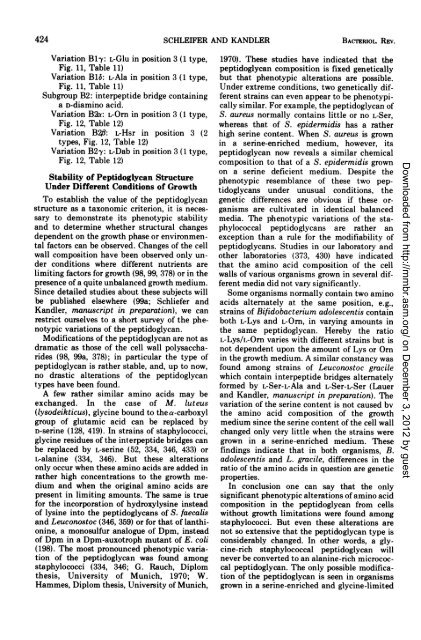Peptidoglycan .Types of Bacterial Cell Walls and their Taxonomic ...
Peptidoglycan .Types of Bacterial Cell Walls and their Taxonomic ...
Peptidoglycan .Types of Bacterial Cell Walls and their Taxonomic ...
You also want an ePaper? Increase the reach of your titles
YUMPU automatically turns print PDFs into web optimized ePapers that Google loves.
424 SCHLEIFER AND KANDLER<br />
BACTERIOL REV.<br />
Variation B1y: L-Glu in position 3 (1 type,<br />
Fig. 11, Table 11)<br />
Variation B16: L-Ala in position 3 (1 type,<br />
Fig. 11, Table 11)<br />
Subgroup B2: interpeptide bridge containing<br />
a D-diamino acid.<br />
Variation B2a: L-Orn in position 3 (1 type,<br />
Fig. 12, Table 12)<br />
Variation B2B,: L-Hsr in position 3 (2<br />
types, Fig. 12, Table 12)<br />
Variation B2Y: L-Dab in position 3 (1 type,<br />
Fig. 12, Table 12)<br />
Stability <strong>of</strong> <strong>Peptidoglycan</strong> Structure<br />
Under Different Conditions <strong>of</strong> Growth<br />
To establish the value <strong>of</strong> the peptidoglycan<br />
structure as a taxonomic criterion, it is necessary<br />
to demonstrate its phenotypic stability<br />
<strong>and</strong> to determine whether structural changes<br />
dependent on the growth phase or environmental<br />
factors can be observed. Changes <strong>of</strong> the cell<br />
wall composition have been observed only under<br />
conditions where different nutrients are<br />
limiting factors for growth (98, 99, 378) or in the<br />
presence <strong>of</strong> a quite unbalanced growth medium.<br />
Since detailed studies about these subjects will<br />
be published elsewhere (99a; Schliefer <strong>and</strong><br />
K<strong>and</strong>ler, manuscript in preparation), we can<br />
restrict ourselves to a short survey <strong>of</strong> the phenotypic<br />
variations <strong>of</strong> the peptidoglycan.<br />
Modifications <strong>of</strong> the peptidoglycan are not as<br />
dramatic as those <strong>of</strong> the cell wall polysaccharides<br />
(98, 99a, 378); in particular the type <strong>of</strong><br />
peptidoglycan is rather stable, <strong>and</strong>, up to now,<br />
no drastic alterations <strong>of</strong> the peptidoglycan<br />
types have been found.<br />
A few rather similar amino acids may be<br />
exchanged. In the case <strong>of</strong> M. luteus<br />
(lysodeikticus), glycine bound to the a-carboxyl<br />
group <strong>of</strong> glutamic acid can be replaced by<br />
D-serine (128, 419). In strains <strong>of</strong> staphylococci,<br />
glycine residues <strong>of</strong> the interpeptide bridges can<br />
be replaced by L-serine (52, 334, 346, 433) or<br />
L-alanine (334, 346). But these alterations<br />
only occur when these amino acids are added in<br />
rather high concentrations to the growth medium<br />
<strong>and</strong> when the original amino acids are<br />
present in limiting amounts. The same is true<br />
for the incorporation <strong>of</strong> hydroxylysine instead<br />
<strong>of</strong> lysine into the peptidoglycans <strong>of</strong> S. faecalis<br />
<strong>and</strong> Leuconostoc (346, 359) or for that <strong>of</strong> lanthionine,<br />
a monosulfur analogue <strong>of</strong> Dpm, instead<br />
<strong>of</strong> Dpm in a Dpm-auxotroph mutant <strong>of</strong> E. coli<br />
(198). The most pronounced phenotypic variation<br />
<strong>of</strong> the peptidoglycan was found among<br />
staphylococci (334, 346; G. Rauch, Diplom<br />
thesis, University <strong>of</strong> Munich, 1970; W.<br />
Hammes, Diplom thesis, University <strong>of</strong> Munich,<br />
1970). These studies have indicated that the<br />
peptidoglycan composition is fixed genetically<br />
but that phenotypic alterations are possible.<br />
Under extreme conditions, two genetically different<br />
strains can even appear to be phenotypically<br />
similar. For example, the peptidoglycan <strong>of</strong><br />
S. aureus normally contains little or no L-Ser,<br />
whereas that <strong>of</strong> S. epidermidis has a rather<br />
high serine content. When S. aureus is grown<br />
in a serine-enriched medium, however, its<br />
peptidoglycan now reveals a similar chemical<br />
composition to that <strong>of</strong> a S. epidermidis grown<br />
on a serine deficient medium. Despite the<br />
phenotypic resemblance <strong>of</strong> these two peptidoglycans<br />
under unusual conditions, the<br />
genetic differences are obvious if these organisms<br />
are cultivated in identical balanced<br />
media. The phenotypic variations <strong>of</strong> the staphylococcal<br />
peptidoglycans are rather an<br />
exception than a rule for the modifiability <strong>of</strong><br />
peptidoglycans. Studies in our laboratory <strong>and</strong><br />
other laboratories (373, 430) have indicated<br />
that the amino acid composition <strong>of</strong> the cell<br />
walls <strong>of</strong> various organisms grown in several different<br />
media did not vary significantly.<br />
Some organisms normally contain two amino<br />
acids alternately at the same position, e.g.,<br />
strains <strong>of</strong> Bifidobacterium adolescentis contain<br />
both L-Lys <strong>and</strong> L-Orn, in varying amounts in<br />
the same peptidoglycan. Hereby the ratio<br />
L-Lys/L-Orn varies with different strains but is<br />
not dependent upon the amount <strong>of</strong> Lys or Orn<br />
in the growth medium. A similar constancy was<br />
found among strains <strong>of</strong> Leuconostoc gracile<br />
which contain interpeptide bridges alternately<br />
formed by L-Ser-L-Ala <strong>and</strong> L-Ser-L-Ser (Lauer<br />
<strong>and</strong> K<strong>and</strong>ler, manuscript in preparation). The<br />
variation <strong>of</strong> the serine content is not caused bv<br />
the amino acid composition <strong>of</strong> the growth<br />
medium since the serine content <strong>of</strong> the cell wall<br />
changed only very little when the strains were<br />
grown in a serine-enriched medium. These<br />
findings indicate that in both organisms, B.<br />
adolescentis <strong>and</strong> L. gracile, differences in the<br />
ratio <strong>of</strong> the amino acids in question are genetic<br />
properties.<br />
In conclusion one can say that the only<br />
significant phenotypic alterations <strong>of</strong> amino acid<br />
composition in the peptidoglycan from cells<br />
without growth limitations were found among<br />
staphylococci. But even these alterations are<br />
not so extensive that the peptidoglycan type is<br />
considerably changed. In other words, a glycine-rich<br />
staphylococcal peptidoglycan will<br />
never be converted to an alanine-rich micrococcal<br />
peptidoglycan. The only possible modification<br />
<strong>of</strong> the peptidoglycan is seen in organisms<br />
grown in a serine-enriched <strong>and</strong> glycine-limited<br />
Downloaded from<br />
http://mmbr.asm.org/<br />
on December 3, 2012 by guest




